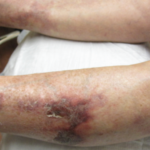In the old days, acute attacks were attenuated with ACTH and I have seen this work on several occasions. In your case, this might be like flogging a very tired horse. I doubt anyone could argue that a low, physiologic dose of systemic corticosteroid (prednisolone <8mg/d) produces immunosuppression and might be sufficient for the acute attack. If your patient had a brochospastic component, the pulmonary specialist would likely have recommended >2 mg/kg Q8hr with impunity. I would also give colchicine 0.6 mg BID for prophylaxis.
Matthew O. Swartz, MD, Rheumatologist
Prince William Hospital, Manassas, Va.
I suggest either a moderated dose of systemic corticosteroids (i.e., prednisone 10 to 15 mg daily with a tapering regimen over two weeks) with continued close monitoring of fluid status or, if a clinician were feeling cavalier (vs. naive) enough or truly believed in his or her dexterity with a needle, an intra-articular corticosteroid injection to the affected gouty joint.
I recently had a similar situation and was able to maneuver a pleasant elderly woman out of it with the former tactic (though she had several affected gouty joints). Additionally, I have previously provided intra-articular corticosteroid injections to gouty joints in individuals who were anti-coagulated with thankful success. (Whether I possessed the correct thought process in attempting such a procedure under those conditions can be debated.) But I count my lucky stars that those individuals were able to avoid any complications from the procedure.
Lastly, I would also determine which option the treated individual prefers and/or is comfortable with and base my ultimate decision on their preference.
Dennis M. Liu, MD, Rheumatologist
Tuality Community Hospital, Hillsboro, Ore.
I have treated similar patients by injecting the joint with a 27-gauge, 1.5-inch needle. No problem with hemostasis.
Benjamin Lechner, MD, Rheumatologist
Hallandale, Fla.
Your patient was characteristic of 95% of those we now see, and meets “Lightfoot’s Criteria for Gout Needing a Rheumatologist”:
- Veteran;
- Heavy smoking history;
- Bruits in at least six sites, including at least one renal artery;
- Ejection fraction less than or equal to 25%;
- Creatinine around 2.5mg/dL on his or her best day;
- On coumadin for at least two of the following reasons:
- Ventricular dilation with akinetic areas;
- Recurrent thrombophlebitis;
- Recurrent arterial thrombi from their plaques; and
- An artificial heart valve.
- Enough exposure to alcohol to compromise easy regulation of prothrombin times; and
- Bronchopneumonia from tobacco-related lung disease.
In that setting, every drug for gout is contra-indicated. Therefore, the clinical decision-making is easy. You use the drug that is least worst.

